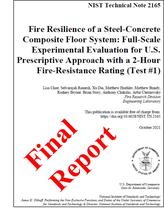Steel-Concrete Composite Floor (Test #1)

This first experiment was conducted on November 14, 2019 to quantify the performance the 9.1 m x 6.1 m composite floor specimen designed to achieve a 2-hour fire-resistance rating to generate baseline data for current U.S. practice. The fire test bay was situated on the ground floor in the middle edge bay of the test building, and the composite floor specimen had the minimum steel reinforcement (6x6 W1.4xW1.4 mesh mat with the distributed area of 60 mm2/m) prescribed for concrete crack control in normal conditions and permitted in standard furnace testing. This specimen was not subjected to controlled cooling nor mechanical loading during the cooling phase of a test fire.
DATA
Spreadsheets containing the Test #1 data can be downloaded here (click link).
Video Gallery
RELATED PUBLICATIONS
- Choe, L.Y.; Ramesh, S.; Dai, X.; Hoehler, M.S.; Bundy. M.F.: Experimental study on fire resistance of a full-scale composite floor assembly in a two-story steel framed building, Journal of Structural Fire Engineering, 2021.
- Choe, L.Y., Ramesh, S., Dai, X., Hoehler, M.S., Bundy, M.F., Bryant, R., Story, B., Chakalis, A.; Chernovsky, A.: Fire Resilience of a Steel-Concrete Composite Floor System: Full-Scale Experimental Evaluation for U.S. Prescriptive Approach with a 2-Hour Fire-Resistance Rating (Test #1), NIST Technical Note 2165, 2021, pgs. 176.

